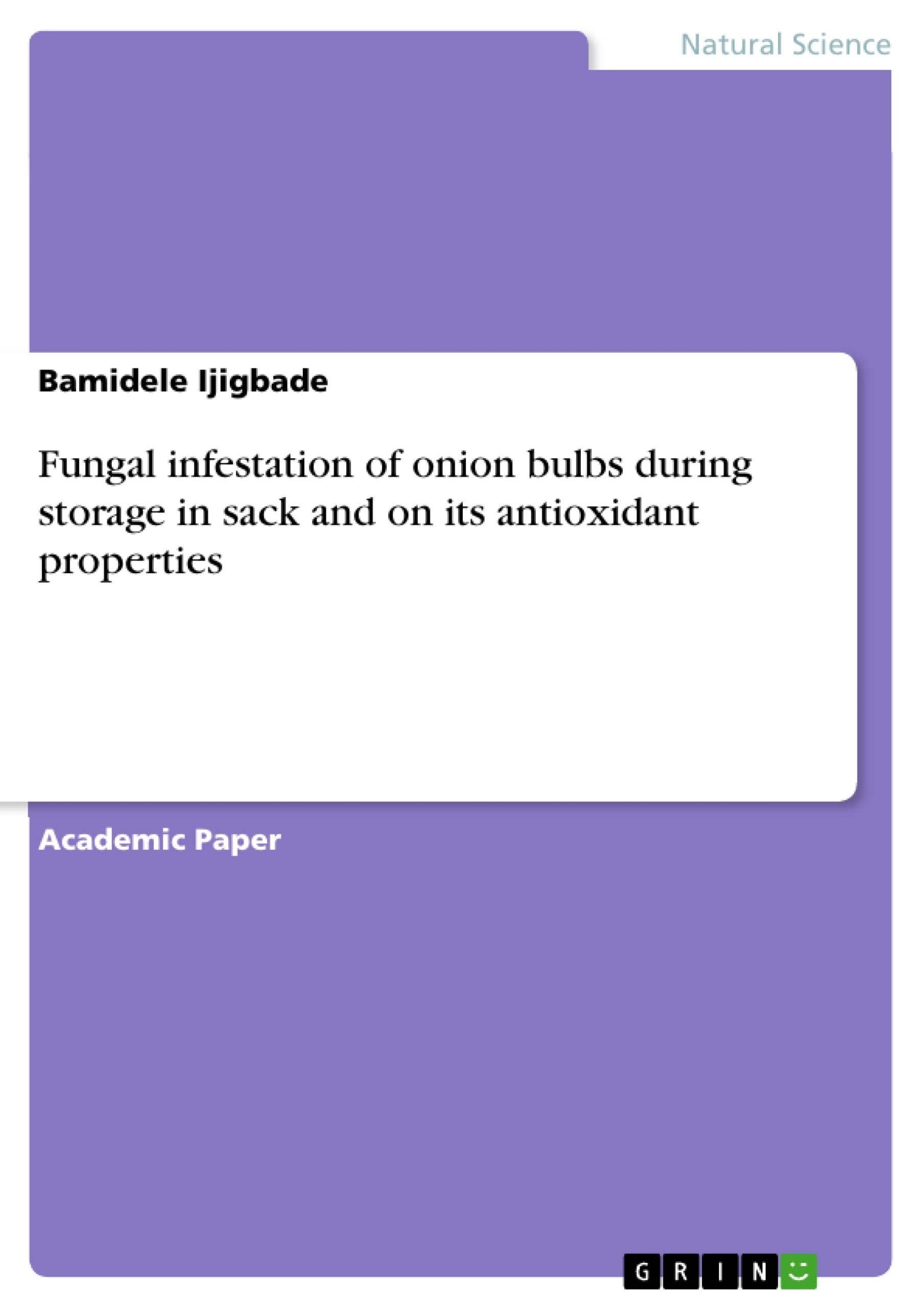The aim of this study is to determine fungal infestation of onion bulbs during storage in sack and on its antioxidant properties.
The fungal infestation of onion bulbs during storage in sack shows that five fungi each were isolated from the onion bulbs during storage in sack at day zero and day seven respectively while at day fourteen, six fungal infestations were isolated from the onion bulbs during storage in sack. A total of sixteen fungi infested the onion bulbs during storage in sack. The fungi belong to four genera and six species of fungi infested the onion bulbs during storage in sack.
Aspersillus niger and Aspersillus flavus were the most frequently isolated fungi with 31.25% each followed by Fusarium oxysporum and Aspergillus fumigatus with 12.50% each while Penicillium chrysogenum and Rhizopus stolonifer recorded 6.25% each. The antioxidant analysis of onion extract after storage in sack for 14 days recorded at all concentrations, show that the antioxidant property of the onion extract at day zero and day 7 was higher than that of 14. The inhibition of free radical DPPH at day zero and 7 were 29.92 %, 49.21%, 69.29%, 70.07% and 47.63% while at day 14, the percentage (%) of inhibition of free radical DPPH were 29.33 %, 49.02%, 69.01%, 69.77% and 47.21%.
Healthy, undamaged onion bulbs which have been dried in the field should be stored in dry, well ventilated stores. This will reduce growth and development of fungal pathogens and minimize storage rots. Therefore, A. cepa and its constituents could be of therapeutic value in disorders such as aging, anti-inflammatory, and wound healing processes where radical scavenging activity can be of therapeutic value.
Contents
Abstract
1.0 Introduction
1.1 Background of the Study
1.2 Aim of the Study
1.3 Objectives of the Study
2.0 Literature Review
2.1 Uses of Allium cepa
2.2 Post-harvest losses in onion
2.3 Microorganisms Associated with Onion Spoilage in Nigeria
2.4 Antioxidant effects of A. cepa
2.5 Antimicrobial activity
3.0 Materials and Methods
3.1 Study Area
3.2 Materials used and Sterilization
3.3 Collection of Samples
3.4 Storage of Onion Bulb in Sack Bag
3.5 Preparation and sterilization of media
3.6 Assessment of Fungal Infestation of the Onion bulb during Storage
3.6.1 Preparation of pure cultures of fungal isolates
3.7 Identification of fungal isolates
3.8 Determination of Frequency of Occurrence of Fungal Isolates
3.9 Preparation of Onion Extract
3.10 Determination of antioxidant Properties of Onion
3.10.1 DPPH Free radical scavenging assay
3.10.2 Measurement of reducing power of the crude extracts of Onion Bulb
3.10.3 Determination of antioxidant activity of crude extracts of the Onion
3.11 Statistical Analysis
4.0 Results
4.1 Fungal Infestation of Onion Bulbs during Storage in Sack
4.2 Frequency and Percentages of Fungal Infestation of Onion Bulbs
4.3 DPPH radical scavenging activity of Fungal Infested Onion Bulbs during Storage in Sack
5.0 Discussions and Conclusion
5.1 Discussions
5.2 Conclusion
5.3 Recommendation
References
- Quote paper
- Bamidele Ijigbade (Author), 2022, Fungal infestation of onion bulbs during storage in sack and on its antioxidant properties, Munich, GRIN Verlag, https://www.grin.com/document/1312514
-

-

-

-
Upload your own papers! Earn money and win an iPhone X. -

-
Upload your own papers! Earn money and win an iPhone X. -

-
Upload your own papers! Earn money and win an iPhone X. -

-
Upload your own papers! Earn money and win an iPhone X. -

-
Upload your own papers! Earn money and win an iPhone X. -

-
Upload your own papers! Earn money and win an iPhone X. -

-
Upload your own papers! Earn money and win an iPhone X. -

-
Upload your own papers! Earn money and win an iPhone X. -

-
Upload your own papers! Earn money and win an iPhone X.

